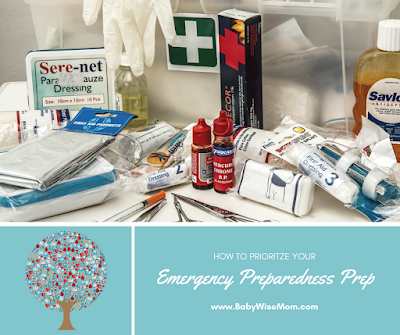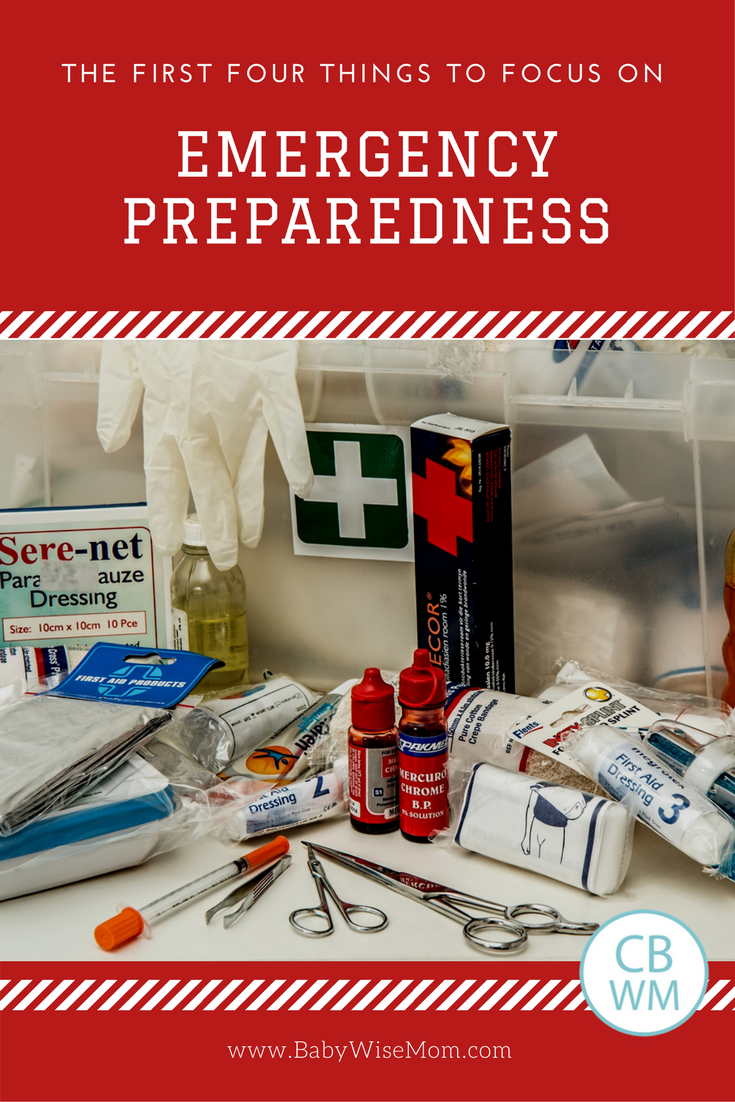I have no doubt that with all of the natural disasters that have hit recently that you have your family’s emergency preparedness status on your mind. As you sit down to think about and plan out what you need to do for emergency preparedness, it quickly becomes overwhelming. There is so much to do that time and money are both very real limits on what can be accomplished right away. There is an order of priorities when it comes to emergency preparedness, so let’s discuss what those are.

Each year, we review our emergency preparedness in early October and early April–so every six months. We make goals for the next six months and review what we already have completed to be sure everything is still up to date. As you approach your plan, think of it in shorter increments like this, also. Don’t get it all today (unless you have plenty of money to do so). Make attainable 6 month goals.
First: Emergency Supply Kit
Your first priority needs to be a 72 Emergency Supply Kit for each member of your family. You need enough supplies that you could survive for three days without any assistance from anyone or anything if you were cut off from modern civilization today. I think at times we find this a hard thing to believe could happen, but with the recent disasters, we all have seen or even experienced that this can be true.
Be prepared for this kit to need to be taken out of your home. It needs to be portable. Because of the nature of “emergencies,” you won’t know for sure if you will need to take it out of your home or not. Maybe you will be in your home and use it from there. In case not, you want to have the kits in something portable.
Like I said, I review emergency preparedness every six months, and I tend to write about the things on my mind, so I have some posts on several of these topics I will refer you to.
As you approach your kits, you can either build them up slowly over time or you can just buy a pre-made kit and then build on that.
Also, don’t overlook the need for emergency supplies in your vehicle: Emergency Kits for the Vehicle.
Most areas have common natural disasters and weather impacts. This page will help you focus on being prepared for the disasters that can strike you.
Second: Have a Water Supply
When I think about surviving with nothing, I know water is top priority. You obviously need water to drink for survival. You also need it for cooking and for hygiene.
In your 72 hour emergency kit, you should have three days of water. That is why the kit comes before water. If you build your kit slowly, focus on water needs first. Once your kit is completed, store more water in your home if you have the space. For lots of help on this, see my post: Storing Water for Emergencies
In an emergency, when people have some time to prepare, the water is quickly cleared out of every store. Do not wait until a hurricane is coming your way to head to the store and stock up on water. Have supplies in your home at all times. Then you are guaranteed to have it, even if the store is out when you get there.
Third: Make a Plan
Good news! Making a plan is free. While I have this third, because it is free, it can be focused on while working on gathering the supplies above. When I was in college, I took a natural disasters class. In that class, I had to make a plan as an assignment. Where would I go if an emergency came up? What would I do if the roads out of my town were all blocked off for some reason? How would I get in touch with family?
This was an eye-opening exercise. Now that I have children, having a disaster plan is even more important. One thing we do well is practice in case of house fire. We need to do practices for other types of emergencies. We do our practices every six months while we are thinking about emergency preparedness.
Here are two helpful articles on making a plan:
Fourth: Build Up a Food Storage
If you have the space in your home, build up a food storage for emergencies. We aim for a 1-2 year supply of items. This is listed last because you want to focus on the immediate emergency needs first.
Having a food storage is financially very beneficial. It is of course handy for the unforeseen events that can hit your budget–a job loss, a medical emergency that brings bills, etc. It is also helpful for cutting your weekly grocery bill down. I tend to only buy things if they are on sale. So when pasta goes on crazy sale for less than one dollar per bag, I load up. I look like a crazy lady who really, really likes pasta (I mean, I do, but that is beside the point). I have gotten many weird looks and even questions from cashiers. But I rarely, if ever, pay full price for pasta. I don’t even pay “eh” sale prices. I only pay killer sale prices. I do that with all non-perishables. I also do it with some perishables. When sour cream is on sale, for example, I buy as much as I think I will need before the expiration date is up. For more, see Emergency Preparedness: Food Storage.
If you are feeling a little anxious with the natural disasters that have happened as of late, hopefully this gives you some guidance as you work to get your family prepared in case you face a natural disaster in the future.

- 72 Hour Kits
- 72 Hour Kit Food
- 72 Hour Kit Tips
- 72 Hour Kit Free Printables
- Emergency Preparedness Binder
- Emergency Preparedness: Food Preserving
- Teaching Children Fire Safety
- Emergency Preparedness: Food Storage
- Emergency Prepardness: Lifefolio
- What to Keep in Your Car in Case of Emergency
Emergency Kits for the Vehicle
-
Storing Water for Emergencies
